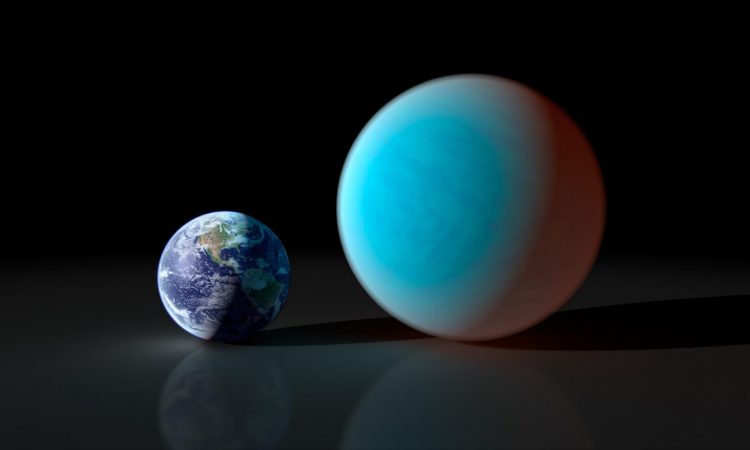Ground-based detection of super-Earth transit paves way to remote sensing of exoplanets

This image shows Earth and Super-Earth. Credit: NASA/JPL
The transit of the exoplanet 55 Cancri e is the shallowest detected from the ground yet, and the success bodes well for characterizing the many small planets that upcoming space missions are expected to discover in the next few years.
The international research team used the 2.5-meter Nordic Optical Telescope on the island of La Palma, Spain – a moderate-sized facility by today's standards – to make the detection. Previous observations of this planet transit had to rely on space-borne telescopes.
During its transit, the planet crosses its host star, 55 Cancri, located just 40 light-years away from us and visible to the naked eye, blocking a tiny fraction of the starlight, dimming the star by 1/2000th (or 0.05%) for almost two hours.
“Our observations show that we can detect the transits of small planets around Sun-like stars using ground-based telescopes,” says Dr. Ernst de Mooij, of Queen's University Belfast, UK, the study's lead author. “This is especially important because upcoming space missions such as TESS and PLATO should find many small planets around bright stars.”
TESS is a NASA mission scheduled for launch in 2017, while PLATO is to be launched in 2024 by the European Space Agency; both will search for transiting terrestrial planets around nearby bright stars.
“It's remarkable what we can do by pushing the limits of existing telescopes and instruments, despite the complications posed by the Earth's own turbulent atmosphere,” says Jayawardhana, the study's co-author and de Mooij's former postdoctoral supervisor. “Observations like these are paving the way as we strive towards searching for signs of life on alien planets from afar. Remote sensing across tens of light-years isn't easy, but it can be done with the right technique and a bit of ingenuity.”
The planet 55 Cancri e is about twice as big and eight times as massive as the Earth. With a period of 18 hours, it is the innermost of five planets in the system. Because of its proximity to the host star, the planet's dayside temperature reaches over 1700 Celsius – hot enough to melt metal – with conditions quite inhospitable to life.
Initially identified a decade ago through radial velocity measurements, it was later confirmed through transit observations with MOST and Spitzer space telescopes. Until now, the transits of only one other super-Earth, GJ 1214b circling a red dwarf, had been observed with ground-based telescopes. The Earth's roiling air makes such observations extremely difficult. But the team's success with 55 Cancri e raises the prospects of characterizing dozens of super-Earths likely to be revealed by upcoming surveys.
Next, the team plans to search for steam (water) in the planet's atmosphere.
The research team also includes Mercedes Lopez-Morales of the Harvard-Smithsonian Center for Astrophysics, as well as Raine Karjalainen and Marie Hrudkova of the Isaac Newton Group of Telescopes. Their findings will appear in the Astrophysical Journal Letters.
York University is helping to shape the global thinkers and thinking that will define tomorrow. York U's unwavering commitment to excellence reflects a rich diversity of perspectives and a strong sense of social responsibility that sets us apart. A York U degree empowers graduates to thrive in the world and achieve their life goals through a rigorous academic foundation balanced by real-world experiential education. As a globally recognized research centre. York U is fully engaged in the critical discussions that lead to innovative solutions to the most pressing local and global social challenges. York U's 11 faculties and 25 research centres are thinking bigger, broader and more globally, partnering with 280 leading universities worldwide. York U's community is strong? 55,000 students, 7,000 faculty and staff, and more than 270,000 alumni.
Media Contact
More Information:
http://www.yorku.ca/All latest news from the category: Physics and Astronomy
This area deals with the fundamental laws and building blocks of nature and how they interact, the properties and the behavior of matter, and research into space and time and their structures.
innovations-report provides in-depth reports and articles on subjects such as astrophysics, laser technologies, nuclear, quantum, particle and solid-state physics, nanotechnologies, planetary research and findings (Mars, Venus) and developments related to the Hubble Telescope.
Newest articles

NASA: Mystery of life’s handedness deepens
The mystery of why life uses molecules with specific orientations has deepened with a NASA-funded discovery that RNA — a key molecule thought to have potentially held the instructions for…

What are the effects of historic lithium mining on water quality?
Study reveals low levels of common contaminants but high levels of other elements in waters associated with an abandoned lithium mine. Lithium ore and mining waste from a historic lithium…

Quantum-inspired design boosts efficiency of heat-to-electricity conversion
Rice engineers take unconventional route to improving thermophotovoltaic systems. Researchers at Rice University have found a new way to improve a key element of thermophotovoltaic (TPV) systems, which convert heat…



